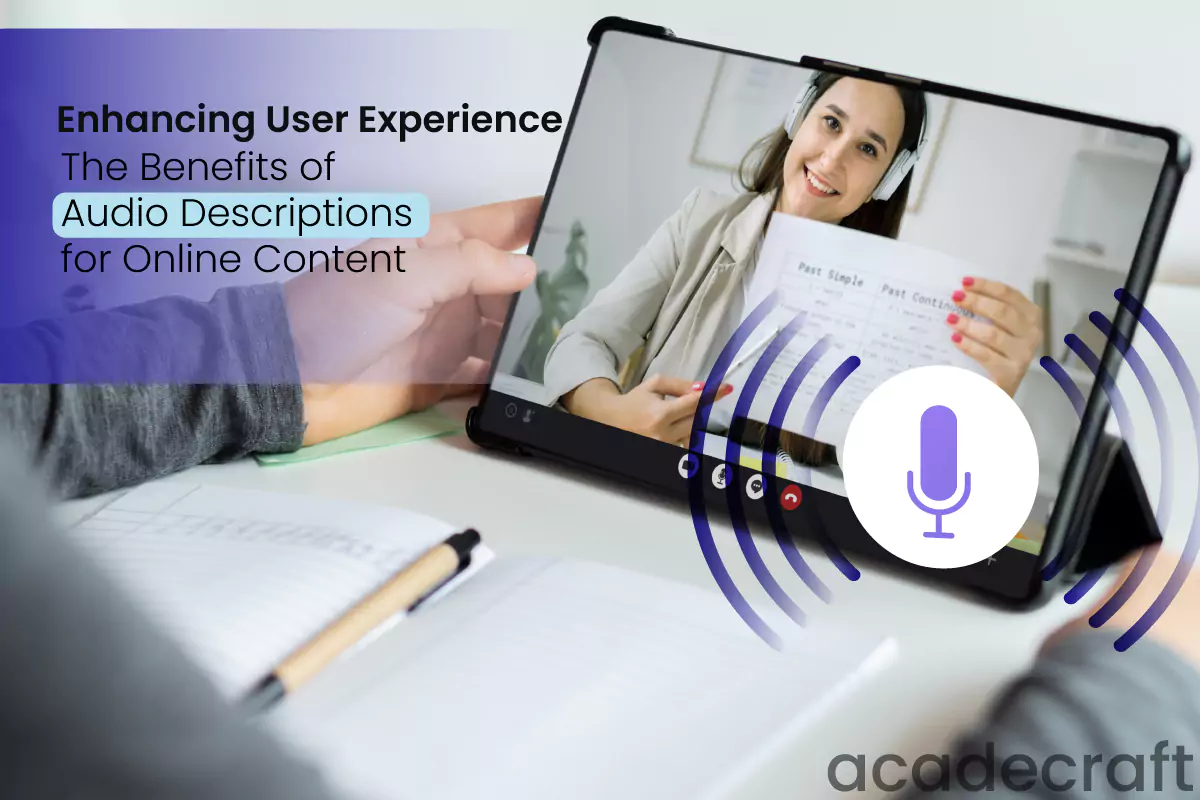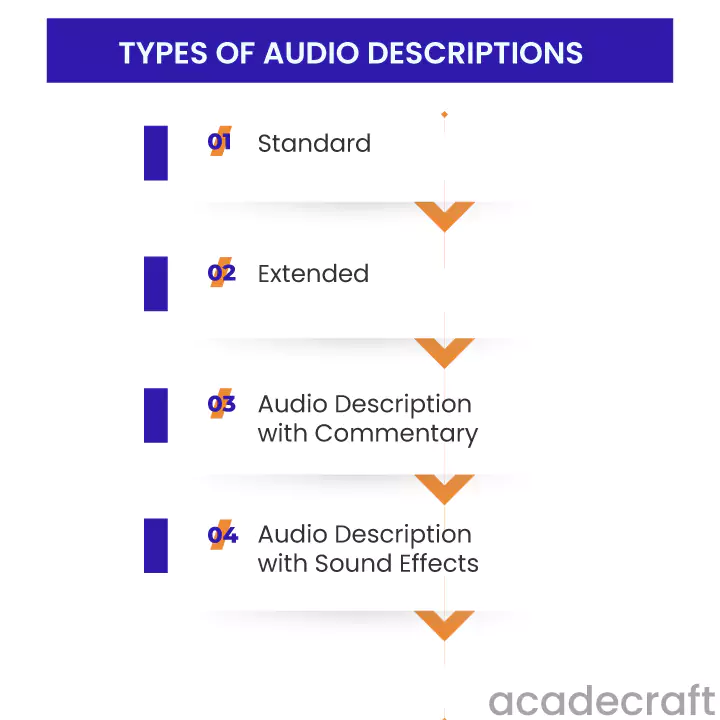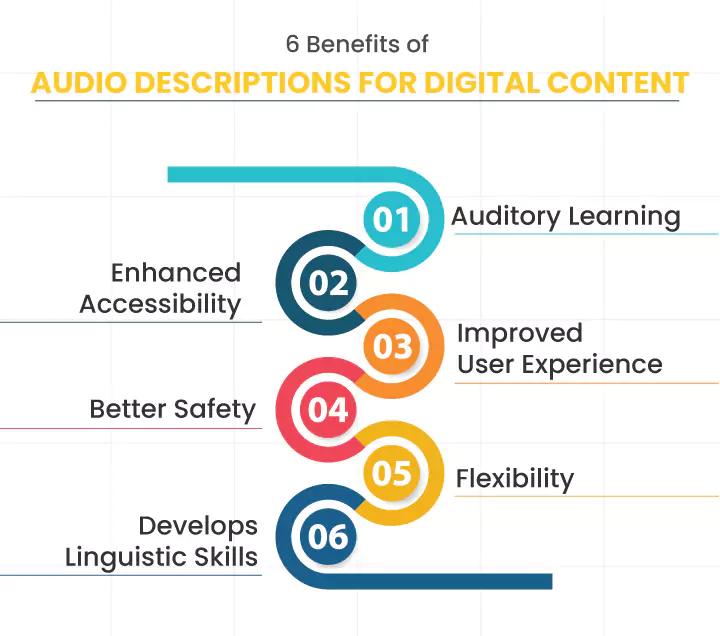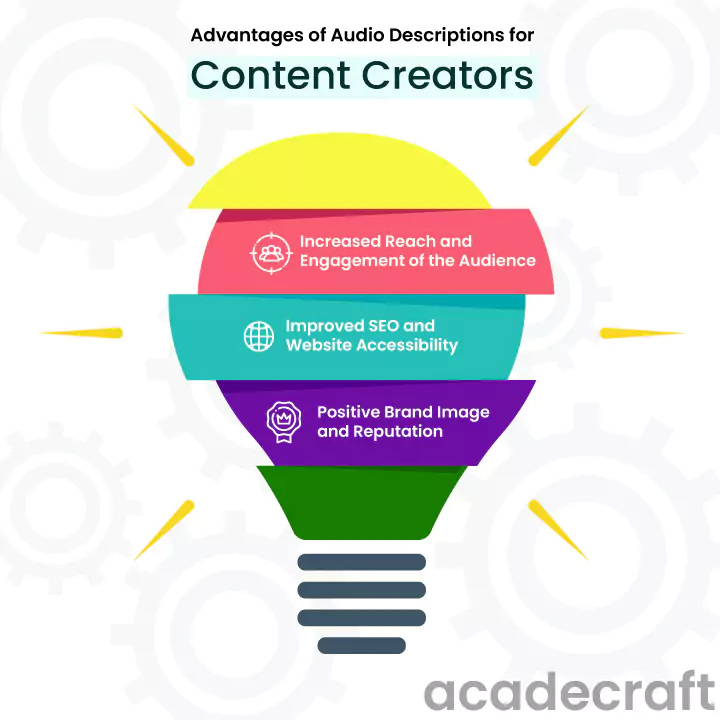
Thousands of people use online content daily, making it an important part of our lives. However, for people with visual impairments, consuming online content can be a challenging experience. Audio descriptions have been introduced to enhance the user experience by overcoming this barrier.
Audio descriptions provide a verbal narration of visual elements in online content, making it accessible to people with visual impairments. In this blog, we will explore the importance of audio descriptions for online content, learn about their advantages, and how they enhance the user's experience.
Audio descriptions are an accessibility feature that provides an audio narration of digital and visual content, such as videos and images. These descriptions help individuals with visual impairments understand the visual elements of online content they would otherwise miss out on.
By providing a detailed account of what is happening on screen, audio descriptions enable users to fully engage with online content in an informative and enjoyable way.
The importance of audio descriptions for online content cannot be overstated, as they play a critical role in promoting accessibility and inclusivity in the digital world. Audio descriptions provide a detailed account of the visual elements of videos and images, enabling users to fully engage with online content in an informative and enjoyable way.
Without audio descriptions, individuals with visual impairments would miss important details and context crucial to understanding the content.
By investing in professional audio description services businesses can promote accessibility and inclusivity, ensuring everyone has proper digital content access. It can enhance the overall user experience by providing all users with a more interactive and engaging experience.

Audio descriptions are narrated descriptions of video content designed to provide accessibility to people who are visually impaired or blind. They help to enhance the viewing experience by describing the visual content. Different types of audio descriptions can be used to achieve this goal.
It is the most common type of audio description used. The narrator describes the video's visual content clearly and concisely, providing information about the setting, characters, actions, and other relevant visual elements. Standard audio descriptions are usually inserted into the pauses in the dialogue to avoid interrupting the viewing experience.
Extended audio descriptions provide a more detailed description of the visual content than standard audio descriptions. Its description type is particularly useful for videos with complex visual elements or fast-paced action scenes. The narrator provides a more detailed description of the setting, characters, and actions to ensure the viewer fully understands what is happening on the screen.
Audio description with commentary is an audio description that includes additional information about the video content. The narrator describes the visual elements and provides background information about the video, such as the director, actors, and other details that may interest the viewer.
Audio descriptions with sound effects are a type of audio description that includes additional sound effects to enhance the viewing experience. The sound effects are used to provide additional information about the visual elements of the video, such as the sound of a car engine or a crowd cheering.
Read Also: How to add an Audio Description to the video?

One of the key benefits of audio descriptions for digital content is that they provide a valuable tool for auditory learning. It is particularly important for individuals who are visually impaired or blind, as it allows them to access and understand visual content in a way that would otherwise be impossible.
Audio descriptions provide a detailed and immersive experience, allowing users to fully engage with digital media and gain a deeper understanding of its content. Digital accessibility service providers can assist you by providing audio descriptions to help you with auditory learning.
Audio descriptions offer a powerful tool for making digital content more inclusive and accessible to a wider range of users. It enhances accessibility for individuals with other disabilities.
For example, those with cognitive or language impairments may benefit from clear and concise descriptions of visual content. Moreover, audio descriptions can be useful for individuals who are deaf or hard of hearing, as they can provide a detailed description of visual elements that may be missed through closed captioning alone.
Audio descriptions also improve user experience by providing a more engaging and immersive experience. By describing visual elements in detail, users can understand and appreciate the content they consume.
When users are more engaged and retain information better, it can result in a more satisfying overall user experience. Additionally, audio descriptions can help users navigate complex or unfamiliar digital environments by providing context and guidance for visual elements that may be difficult to interpret independently.
Incorporating audio and visual elements into digital environments can greatly enhance the user experience, particularly regarding safety. By providing detailed descriptions of potential hazards or safety protocols, users can navigate unfamiliar or hazardous environments more confidently and easily.
For example, audio cues can alert users to potential dangers, such as approaching vehicles or hazardous materials. In contrast, visual elements like color coding or iconography can help users quickly identify safe zones or emergency exits.
Interactive simulations and virtual reality experiences can provide users with hands-on training in a safe and controlled environment, allowing them to practice responding to emergencies without risking themselves or others.
Incorporating audio and visual elements into digital safety protocols can greatly improve user engagement and retention of important information while promoting safer practices in various settings.
Another key advantage of digital safety protocols is their flexibility. Unlike traditional methods, digital safety training protocols offer personalized options to meet the unique needs and requirements of various industries, organizations, and job roles.
It means that users can receive targeted training relevant to their work environment and job responsibilities, helping them better understand the potential hazards they may face and how to respond appropriately.
This flexibility also allows for remote training options, making it easier for users who work in different locations or on different schedules to receive the necessary training.
The flexibility of digital safety protocols makes them a valuable tool for promoting workplace safety and reducing the risk of accidents or injuries.
In addition to promoting workplace safety, digital safety protocols also offer benefits for employee development. Users can improve their linguistic skills and expand their knowledge of industry-specific terminology by utilizing online employee training modules and resources.
It can be especially beneficial for employees who are non-native speakers or who are new to the industry. Digital safety protocols also provide opportunities for interactive learning, such as quizzes and simulations, which can help employees practice using technical language in a practical setting.
The use of digital safety protocols not only promotes workplace safety but also supports employee growth and development.

Audio descriptions are an essential tool for content creators to increase the reach and engagement of their audience. By providing a detailed narration of visual elements in a video, audio descriptions enable visually impaired individuals to access and enjoy the content.
It expands the audience and enhances engagement by providing an inclusive experience for all viewers.
Audio descriptions also improve website accessibility and search engine optimization (SEO). By including audio descriptions in videos, content creators can improve the accessibility of their website for visually impaired individuals using website accessibility services.
It demonstrates a commitment to inclusivity and helps boost SEO by improving the website's overall user experience. Moreover, more people accessing and engaging with the content can increase traffic and higher rankings on search engines.
Besides improving website accessibility and SEO, incorporating audio descriptions into video content can contribute to a positive brand image and reputation. When companies prioritize inclusivity and accessibility, they can establish trust with their audience and demonstrate their values.
It can result in increased brand loyalty and positive word-of-mouth marketing. Moreover, companies prioritizing accessibility are more likely to attract and retain diverse talent, enhancing their reputation as an inclusive and forward-thinking organization.
Bonus Read: Accessibility Audit Services: Everything That Brands Need To Know
Audio descriptions at the movies also help to increase accessibility to content for those with visual impairments. They verbally describe the visuals on-screen, including characters, actions, and settings. By providing audio descriptions, content creators can make their content more accessible and reach a larger audience.
Our accessibility audit service provides various accessibility remediation solutions that can help bridge the gap between those with visual impairments and content creators, improving user experience.
It can improve engagement with content by providing more information to the audience. Audio descriptions can further enhance engagement with content by providing additional context and visual cues to supplement the written material. It can open up a world of new possibilities for online content creators, allowing them to reach wider audiences.
Share